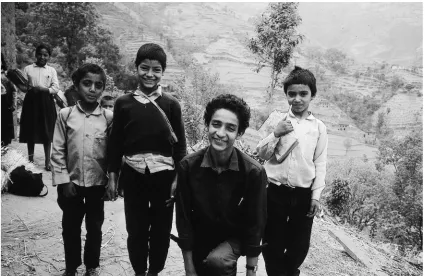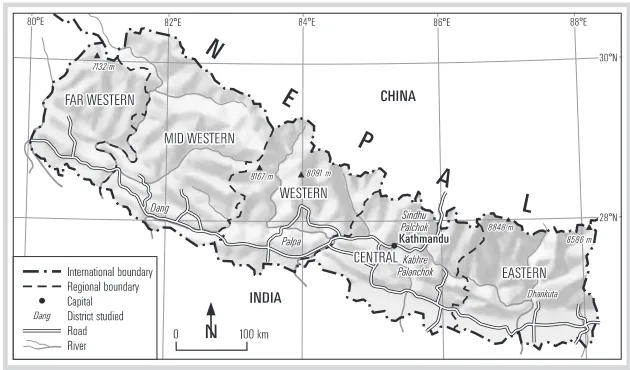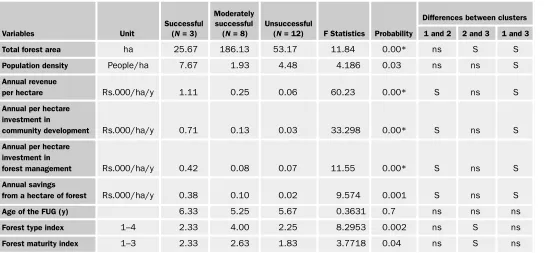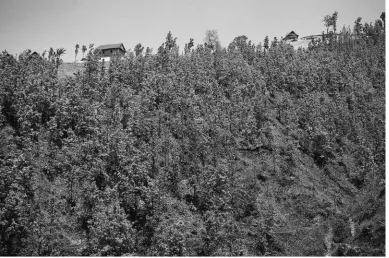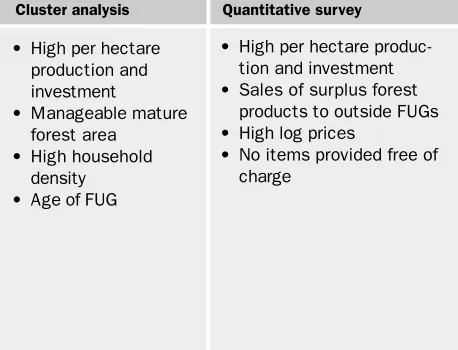Introduction
In recent years, community participation has been increasingly regarded as a necessary basis for effective sustainable development and for determination of the overall quality of development projects, including forest conservation (UN 1990; Cernea 1992; Narayan 1996). Sustainable development is defined as development that meets the needs of the present without compromis-ing the ability of future generations to meet their own needs (WCED 1987).
Community forestry is one form of participation in managing forests owned by the community. It evolved during the 1980s as a means of both resolving environ-mental problems associated with deforestation and sat-isfying the subsistence needs of rural communities. For the purposes of this study, sustainability of community forestry means utilization, development, and conserva-tion of forest resources for continual improvement of the living conditions of subsistence farmers in a given rural community. However, community forestry will not
be made sustainable simply by granting responsibilities to local communities. Indeed, community groups, even with self-motivated and active participants, do not in themselves ensure the sustainability of organizations or the achievement of set objectives (UN 1990): various conditions need to be met before such groups are suc-cessful in meeting their goals.
The experience of participatory initiatives in many Asian countries has shown that the sustainability of com-munity-based organizations depends on a common interest, capital formation, capacity building, grooming activists, and formal organization. The absence of any of these factors casts serious doubts on the long-term via-bility of a community-based organization because the factors are complementary (IFAD 1997). Whereas many studies have been done on most factors, little attention has been paid to capital formation (Dongol 1999).
This study deals with capital formation in order to understand its role in contributing to the sustainability of community forestry in Nepal. Capital is a stock of wealth that can yield goods and services in the future (Robb 1981; Daly 1994). In the present context, capital formation is defined as an accumulation of financial, human, and natural capital. The present study is con-cerned mostly with the human and financial capital of forest user groups (FUGs). Financial capital is a stock deposited into a community savings account. Human capital consists of the skilled and unskilled manpower and the facilities and infrastructure created in a rural area through the use of the financial resources generat-ed from community forestry. A particular objective of the study was to determine the characteristics of a suc-cessful FUG in Nepal. Additional objectives were to determine how the community generates and manages the funds collected for sustainable development and the impact of sustainable development on the forest management regime and rural development (Figure 1). The study argues that capital formation has played a role in drawing local attention to sustainable manage-ment of community forests in Nepal.
Community forestry in Nepal
Forests provide timber and fuelwood for households and fodder for livestock, thus playing a major role in the Nepalese economy, which is based largely on subsis-tence agriculture and tourism. However, population growth has contributed to deforestation, threatening the sustainability of Himalayan ecosystems. Concern about deforestation led to the implementation of a community forestry scheme (Hausler 1993).
Forest management policies in Nepal have under-gone considerable change in recent decades. The main thrust has been the handing over of control and responsibility for the management of forests to local
This article investi-gates the role of capi-tal formation in con-tributing to the sus-tainability of
community forestry in Nepal, using a case study approach based on 23 forest user groups (FUGs). FUGs were classified in 3 categories on the basis of cluster analysis: (1) success-ful, (2) moderately successsuccess-ful, and (3) unsuccessful clus-ters. The results show that the elements of capital accu-mulation in a successful FUG were manageable mature forest, high prices for forest products, a system of charg-ing for all forest products, and sales of surplus forest products outside the FUG. The results also suggest that the benefits of funds, community development, and for-est improvement changed people’s vision and behavior, as well as their attitude toward and understanding of community forestry. This change in attitude has increased interest in and awareness of community forestry and has stimulated thinking about the sustain-ability of community forestry. Local initiative of this sort makes community forests more secure, protected, and wisely managed for sustainable development.
Keywords:Community forestry; capital formation; Nepal; sustainable development; cluster analysis.
Peer reviewed:January 2001.Accepted:June 2001.
Capital Formation and Sustainable
Community Forestry in Nepal
Chandra Man Dongol, Kenneth F. D. Hughey, Hugh R. Bigsby
70
Research
71
people (Adhikari 1990). The Forestry Master Plan (1988) allocated more than 45% of the total budget for community forestry (HMGN 1988). Despite its high pri-ority, community forestry was not popular in rural munities in Nepal before 1990. This was because com-munity forestry activities concentrated on tree planta-tions, and FUGs were given barren areas or degraded forests with plantations (Shrestha 1995). Such areas require many years before the benefits are apparent. Furthermore, there was no clear judicial arrangement of bylaws empowering FUGs before 1990. Consequently, communities did not show great initiative with respect to community forestry.
Progressive steps were taken toward implementing community forestry after changes in the political system in 1990, which led to the formulation and promulga-tion of the Forest Act of 1993 and the Forest Bylaw of 1995. This legislation recognized the importance of participation by local people in forest conservation. It clearly established FUGs as the organizations responsi-ble for regeneration, protection, and harvesting of local community forests. The bylaw delegates authority to the FUGs to develop and use funds at their own discretion after meeting forest management costs. This has provid-ed a range of sizeable benefits, with few costs to the community. Hence, communities are motivated to accept forest management responsibilities. This has resulted in an increase in forest area under community management, from 3592 ha in 1992 to 98,530 ha in 1996 (Joshi 1997). Income generated from the sale of forest products is becoming popular and is perceived as a major incentive for forest conservation and a source
of rural development (Karki et al 1994; Byron 1996; Gautam 1997). However, sustainability of income depends upon how the income is earned and used. It is therefore imperative to understand the role of capital formation in community forestry in Nepal.
Methodology
Cluster analysis
Homogeneous groups are required to determine the characteristics of FUGs. Cluster analysis—a group of multivariate techniques used to classify objects or indi-viduals into homogeneous groups called clusters (Aldenderfer and Blashfield 1984; Hair et al 1995)— was used to generate a few homogeneous groups from many because it is one of the best tools for generating a homogeneous group. Three clusters were identified— successful, moderately successful, and unsuccessful—on the basis of 9 variables considered important in capital formation. Hierarchical and nonhierarchical clustering algorithms were used to determine the cluster number, leaving the final decision on the number of clusters and their members to be made on the basis of a 3-cluster solution provided by the dendrogram drawn from hier-archical algorithms.
Data collection
Five districts, Kabhre Palanchok, Sindhu Palchok, Dhankuta, Palpa, and Dang, in the middle hills and inner Terai of Nepal were selected for this study (Figure 2). Terai is a flat landscape in the southern part of Nepal. These districts were chosen for the following reasons:
Chandra Man Dongol, Kenneth F. D. Hughey, and Hugh R. Bigsby
Mountain Research and Development Vol 22 No 1 Feb 2002
72
• Programs focusing on various aspects of community forestry have been implemented for the last 9 years. A form of capital formation through collection of funds and their utilization in community develop-ment activities has been relatively popular in these districts.
• The districts represent typical hill and inner Terai regions of the country, and so the findings could be applied on a wider scale to other hill and inner Terai districts.
• Relevant secondary data are available from FUGs and district records. Many studies have been done on the other aspects of community forestry, which can pro-vide secondary information about the districts. • The district headquarters are easily approachable,
and a wide range of FUGs was available for the study.
Two data collection methods, a questionnaire sur-vey and interviews were used to explore the role of capi-tal formation in community forestry and, in particular, to evaluate fund collection and management activities and their impacts on community forestry.
The questionnaire survey was used for FUG mem-bers, whereas a semistructured interview was used for committee members and FUG employees. Issues raised during the gathering of data were used as the basis for questions in interviews with government and non-government employees. The format of these research instruments was based on 4 major themes: (1) respon-dents’ knowledge of FUG funds and forest manage-ment; (2) perception of fund raising and the sustain-ability of community forestry; (3) current attitudes about community forestry after collection and utiliza-tion of funds in community development activities; and (4) current feelings about community forestry.
The questions for interviews address fund collec-tion and use, and the effect of capital formacollec-tion (ie, on forest quality, and personal attitudes).
The field research for the study was conducted in Nepal from January 1998 to March 1998. It began with
visits to 5 district forest offices (DFOs), a review of sec-ondary information, selection of FUGs, and conducting of the survey. The DFOs were asked to provide 5 FUGs with various levels of fund collection, in order to obtain a wide range of information from different types of FUGs. Operational plans, minutes of FUG meetings, and monitoring and evaluation reports from 5 FUGs were reviewed.
Key informants were randomly identified from the FUGs and were visited in their homes. Primary data collection employed 3 simple techniques. First, survey questionnaires were distributed to key literate informants. Second, face-to-face discussions on a series of questions from the survey were held with illiterate key informants. Third, face-to-face semistruc-tured interviews took place with key informants involved in the FUG committees and employees work-ing in community forestry. One hundred FUG mem-bers, including 10 women, from 23 FUGs, were con-tacted during the study period. A total of 21 FUG committee members and 19 government and non-government employees were interviewed. Each inter-view took 20–45 minutes.
Statistics
The quantitative data obtained from questionnaire sur-veys were analyzed using the statistical package for social sciences (SPSS). Each question was treated as a variable for analysis. Frequency counts, percentages, means, and standard deviations for different variables were calculated to describe the beliefs of respondents in different clusters. Similarly, cross-tabulation analyses were carried out to determine the relationship between independent, intervening, and dependent variables. Qualitative information was analyzed by using summa-rizing and typologizing techniques. The average value of each variable for each cluster was calculated and pre-sented in tabular form in order to determine the ele-ments of a successful FUG and to reduce the range of information to a few key characteristics.
Research
73
Results
Cluster analysis was carried out using a 2-step process, as previously mentioned. The first stage, Ward’s hierar-chical algorithm using SPSS, was applied to the vari-ables as defined in Table 1.
The Forest Type Index (FTI) in Table 1 represents the type of forest and its value for capital formation. Three broad types were found in the study area and the
following 3 values attributed: 1 = broad leaf forest (less-er value forest), 2 = pine forest, and 4 = sal (Shorea robus-ta)forest. Sal is the most valuable forest and conse-quently was indexed at twice the value of pine (Figures 3 and 4).
The Forest Maturity Index (FMI) refers to the growth stage or maturity of the forest, which is impor-tant for harvesting potential. Three stages were identi-fied: 1 = young, immature, forest, 2 = forest with recent
*Highly significant.
Moderately
Successful successful Unsuccessful Differences between clusters
Variables Unit (N= 3) (N= 8) (N= 12) F Statistics Probability 1 and 2 2 and 3 1 and 3
Total forest area ha 25.67 186.13 53.17 11.84 0.00* ns S S
Population density People/ha 7.67 1.93 4.48 4.186 0.03 ns ns S
Annual revenue
per hectare Rs.000/ha/y 1.11 0.25 0.06 60.23 0.00* S ns S
Annual per hectare
investment in
community development Rs.000/ha/y 0.71 0.13 0.03 33.298 0.00* S ns S
Annual per hectare
investment in
forest management Rs.000/ha/y 0.42 0.08 0.07 11.55 0.00* S ns S
Annual savings
from a hectare of forest Rs.000/ha/y 0.38 0.10 0.02 9.574 0.001 S ns S
Age of the FUG (y) 6.33 5.25 5.67 0.3631 0.7 ns ns ns
Forest type index 1–4 2.33 4.00 2.25 8.2953 0.002 ns S ns
Forest maturity index 1–3 2.33 2.63 1.83 3.7718 0.04 ns S ns
F I G U R E 3 Sal (Shorea robusta)
is a highly valuable wood used for construction and sometimes for traditional carving; its value is thus also cultural – and, from the more recent perspective of the tourism industry, economic. (Photo by Susanne Wymann)
TA B L E 1 Variables used in cluster analysis and averages by cluster. Values given are average values of the FUGs in specific clusters. N= number of FUGs;
Chandra Man Dongol, Kenneth F. D. Hughey, and Hugh R. Bigsby
Mountain Research and Development Vol 22 No 1 Feb 2002
74
regeneration and mother trees, and 3 = mature forest. The highest score indicates a forest with the highest possibility of obtaining timber and nontimber products (NTFPs) from the forest.
The number of clusters and their members was fixed on the basis of 3 cluster solutions provided by the dendrogram drawn from hierarchical algorithms. They were designated as successful, moderately successful, and unsuccessful clusters. Successful clusters had an average annual per hectare income of US$18.50. Mod-erately successful clusters had an average annual per hectare income of US$4.16, whereas unsuccessful clus-ters averaged US$1. The average variable values for each cluster are presented in Table 1. The successful cluster comprised FUGs with high per hectare forest revenues, where more funds were used for community and forest development than in other clusters. The moderately successful cluster had relatively large forest areas, with funds used for community and forest devel-opment activities to some extent. The unsuccessful clus-ter had the lowest per hectare income. As a result, expenditures on community development and forest management activities were far less than in other clus-ters.
The Fstatistics show that 8 out of 9 variables differ significantly between clusters at the 95% confidence level (Table 1). This means that variability within a clus-ter is less than the variability between clusclus-ters. The modified Least Significant Difference (LSD) test (after Bonferroni) was used for multiple comparison tests; the results are presented in the final 3 columns of Table 1.
Discussion
The cluster analysis determined the characteristics of a successful FUG, based on capital formation. Several
fac-tors contributed to the ability of a successful FUG to form capital. One important factor was revenue genera-tion. All FUGs collected some revenue from forest use. Products such as logs, round poles, green fuelwood, and resin were commonly sold, whereas products such as dry fuelwood, tree and grass fodder, leaf litter, and tree seeds were less commonly sold. Most forest prod-ucts were sold to members of the FUG, but some FUGs also sold surplus products outside the community.
Table 2 illustrates that the successful cluster was more likely to be successful in capital formation. The successful cluster tended to sell all forest products at market price rather than giving them free of charge to community members. Sales of forest products were made both inside and outside the community. Howev-er, a few members of the moderately successful and unsuccessful clusters were also involved in forest prod-uct sales outside the community. Moreover, the mem-bers of these clusters sold forest products at a cheap rate, and many FUGs provided some items free. The lower log prices and free distribution of some forest products to members reduced the income per hectare in these clusters.
FUGs spend funds on various activities. Expendi-ture can be divided into 2 main categories: community development and forest management. Community development is a major source of spending, which includes support for education, health, sanitation, and public welfare. Forest management expenses included administration, wages and salaries, tree plantation, and nursery costs.
Table 2 shows that the successful group spent a higher percentage of total income on community devel-opment and less on forest management. Unsuccessful clusters spent a higher percentage of revenue on forest management and less on community development.
Research
75
Although the percentage of spending on forest manage-ment was lower in the successful cluster than in the unsuccessful, the ratio of spending on forest area to for-est management and community development was high-er than in the othhigh-er 2 clusthigh-ers.
The study reveals that ways of thinking about forests have changed since revenues were first generat-ed from community forestry and because these rev-enues were used to implement community development activities. Almost 89% of all respondents believed that revenue collection is helping develop ownership in community forestry within FUGs and that there is a feeling of having one’s own assets in community forestry and protecting forests. Between 82 and 85% of all respondents believed that people discuss the sustain-ability of community forestry and are interested in min-imizing damage in community forestry after capital for-mation (see the final column of Table 3). Almost 83% of all respondents agreed that collecting funds is help-ing to improve forests because of high valuation and protection of forests.
The respondents’ support for these statements decreases from successful to unsuccessful clusters (Table 3). However, a 1-way analysis of variance test does not show significant variation between the clusters, except for the statements about the feeling of having
one’s own assets in community forests (F= 4.123 at
P= 0.231) and the interest in minimizing damage in community forests (F= 3.74 at P= 0.027). This indicates that support for these 2 statements varies significantly between the clusters.
Interview discussions suggested that revenue collec-tion and utilizacollec-tion in community development and for-est management has stimulated greater interaction between community members on how to make future plans and manage funds wisely. As a result, people have demanded training in forest management skills and transparency in fund management. Revenue collection helped make it easy to run tree nurseries and small-scale nontimber forest product plantations, hire observers, and acquire goods and services needed for forest protection and development.
Almost all interviewees indicated that community forests were safer from fire, uncontrolled grazing, and illegal cutting than before. This has increased tree cov-er and improved forest quality. As a result, many birds and wildlife that had disappeared from the forest long ago can now be observed again.
The grouping of forest improvement supporters in clusters shows that a higher percentage of supporters were from the successful cluster, followed by the moder-ately successful and unsuccessful clusters, although
Characteristics Successful (N= 3) Moderately successful (N= 8) Unsuccessful (N= 12)
Number of FUGs involved in
external sales of forest products 2 5 2
Price of log per cubic foot (Rs) 7–125 (72) 10–100 (61) 2–100 (40)
Price of firewood per 100 kg (Rs) 5–10 (7.3) 0–30 (8.8) 0–10 (3.5)
FUGs where everything is sold 100% 75% 58%
Revenue used for forest management 31.57% 25.19% 42.86%
Revenue used for community development 56.55% 40.52% 27.64%
Revenue used for savings 11.88% 34.3% 29.5%
Ratio of forest area to expenditures on
forest and community development activities 1:9:8 1:0.32:0.43 1:2.3:1.64
Successful Moderately Unsuccessful Total
Statement on effect of capital formation (N= 13) successful (N= 43) (N= 44) (N= 100)
Feeling of own assets in community forest (CF) 92 95 81 89
Protection of CF 84 90 89 89
Interested in minimizing damage in CF 90 93 74 85
Developing ownership in CF 90 88 82 88
Discussion of the sustainability of CF 90 79 84 83
Forest improvement because of protection 92 86 77 83
TA B L E 3 Percent in agreement by cluster.
Chandra Man Dongol, Kenneth F. D. Hughey, and Hugh R. Bigsby
Mountain Research and Development Vol 22 No 1 Feb 2002
76
there was a low correlation because of a lower number of respondents in the successful than the moderately successful cluster. This suggests a relationship between users’ motivation in community forestry development and the accumulation of capital. It indicates that capital accumulation within the FUGs was effective in promot-ing sustainable forestry by changpromot-ing people’s attitudes toward community forestry. However, each interviewee from the successful and moderately successful clusters commented that levying charges on forest products has increased the financial burden of disadvantaged groups. This needs to be addressed by providing forest products free of charge in exchange for service in com-munity forestry activities.
Officials working in community forestry believed that FUGs become forest gardeners rather than exploiters after capital formation. They commented that when community forestry began, FUGs were con-cerned about what to harvest. Now they are concon-cerned about how to improve harvesting for sustained growth. This made them think about the best ways of managing forests. Some felt that FUG members were introduced to new ways of thinking and striving for maximum ben-efits after seeing the performance of other high-income FUGs, which motivated them to work hard.
Community development opportunities were part of the benefits recognized from capital formation. Many interviewees noticed changes in users’ attitudes toward community forestry as a result of capital accu-mulation. One interviewee from the moderately suc-cessful cluster commented that there was a negative atti-tude toward community forestry at the beginning of FUG formation. As a result, there was a problem getting enough members to form a FUG. The number of mem-bers in the FUG increased from 72 to 360 in 5 years, as soon as the benefits were noticed. This interviewee fur-ther commented that the community perceived contin-ued benefits from community forestry because the gov-ernment had already handed over forests to the
com-munity. Two interviewees from the successful cluster commented that without the revenues collected, the FUG members would not be interested in forest protec-tion because they believed that the development of community forestry is entirely dependent on how peo-ple perceive community forestry. As a result, some FUGs considered adding value to forest products, recording forest stocks for optimum extraction, plan-ning forest product extraction schemes, and exploring other possible opportunities for higher income. The strong motivation of maximizing returns from commu-nity forestry was common in FUGs where capital forma-tion and experience with forest product marketing were high and the forest was considered as a valuable source for rural development.
By contrast, some professionals working in commu-nity forestry argued that people were highly motivated to demand community forestry just for the trees accu-mulated in the forest. This type of resource acquisition attitude was growing. Moreover, the benefit maximiza-tion motive of FUGs has brought some destructive ideas into the communities. For example, 1 interviewee from the unsuccessful cluster wanted to grow tea by clearing some parts of forests, but the district forest authority rejected the plan. This type of secondary effect of capi-tal accumulation was common in the Dhankuta district. This interviewee commented that other government sectors such as the agricultural, horticultural, and bank-ing sectors should be brought into community forestry as stakeholders to develop appropriate technology for income generation programs and that the role of the Forest Department should be changed from imple-menters to facilitators.
Conclusions
Community forestry in Nepal was used as the basis for a case study to explore the role of capital formation in contributing to sustainable development. Integrated
TA B L E 4 Characteristics of a successful FUG identified in 3 different analyses.
A higher percentage of survey participants and interviewees supported the idea that FUG members:
• Feel ownership of community forestry
• Are interested in the sustainability of the forest • Want to invest in training for forest-based industry
A higher percentage of survey participants and interviewees supported the idea that capital formation is contributing to the sustainability of community forestry in the following ways:
• Supporting rural development activities • Improving forest stock
• Increasing people’s participation • High per hectare
produc-tion and investment • Sales of surplus forest
products to outside FUGs • High log prices
• No items provided free of charge
• High per hectare production and investment
• Manageable mature forest area
• High household density • Age of FUG
Research
77
R E F E R E N C E S
Adhikari J.1990. Is community forestry a new concept? An analysis of the past and present policies affecting forest management in Nepal. Society and Natural Resources3:257–265.
Aldenderfer MS, Blashfield RK.1984. Cluster Analysis.Beverly Hills: Sage Publications.
Byron N.1996. Income generation through community forestry. In:Victor M, editor. Income Generation through Community Forestry: Proceedings of a Seminar,Bangkok, 18–20 Oct 1995. RECOFTC Report 13. Bangkok, Thai-land: Regional Community Forestry Training Center for Asia and the Pacific (RECOFTC), pp 1–14.
Cernea MM.1992. A sociological framework: policy, environment, and the social actors for tree planting. In:Sharma NP, editor. Managing the World’s Forests: Looking for Balance Between Conservation and Development.Iowa: Kandal/Hunt Publishing Company, pp 301–335.
Daly HE.1994. Operationalizing sustainable development by investing in natural capital. In:Jansson AM, Hammer M, Folke C, Costanza R, editors.
Investing in Natural Capital: The Ecological Economics Approach to Sustain-ability.Washington: Island Press.
Dongol CM.1999. The Role of Capital Formation in Contributing to Sustain-able Community Forestry in Nepal.Master of Resource Studies thesis. Lin-coln University, New Zealand.
Gautam KH.1997. Forestry for Sustainable Rural Development in Nepal: Community Forestry Beyond the Subsistence Horizon Towards the 21st Cen-tury.Paper presented at XI World Forest Congress; 13–22 Oct 1997; Antalya, Turkey. Summary available at: www.fao.org/montes/foda/ wforcong/PUBLI/V5/T26E/3-11.HTM TOP
Hair JF, Anderson RE, Tatham RL, Black WC.1995.Multivariate Data Analy-sis With Readings.4th ed. New Jersey: Prentice Hall.
Hausler S.1993. Community forestry: a critical assessment, the case of Nepal. The Ecologist23(3):84–90.
[HMGN] His Majesty’s Government of Nepal.1988. Master Plan for the Forestry Sector Nepal: Main Report.Kathmandu, Nepal: Ministry of Forest and Soil Conservation.
[IFAD] International Fund for Agricultural Development.1997. Indonesia Eastern Islands Smallholder Farming Systems and Livestock Development Project.IFAD Loan 396-ID, Supervision Report. Available from the author on request.
Joshi AL.1997. Empowering local users in forest management in Nepal.
Banko Janakari2(2):32–38.
Karki M, Karki JBS, Karki N.1994. Sustainable Management of Common Forest Resources: An Evaluation of Selected Forest User Groups in Western Nepal.Kathmandu, Nepal: International Centre for Integrated Mountain Development (ICIMOD).
Kidder LH, Selltiz C.1981. Research Methods in Social Relations.4th ed. New York: Holt, Rinehart and Winston.
Narayan D.1996. The contribution of people’s participation: evidence from 121 rural water supply projects. In:Rietbergen-McCracken J, editor. Partici-pation in Practice: The Experience of the World Bank and Other Stakehold-ers.World Bank Discussion Paper No. 333. Washington, DC: International Bank for Reconstruction and Development, pp 24–29.
Robb AJ.1981. Dictionary of Accounting and Finance Terms.3rd ed. Auck-land, New Zealand: Longman Paul.
Shrestha KB.1995. Community forestry in Nepal and an overview of con-flicts. Banko Janakari5(3):101–107.
[UN] United Nations.1990. Participatory Rural Development in Selected Countries: A Report on Action Plan for Multiplication of Participatory Rural Development.Bangkok, Thailand: Interagency Committee on Integrated Rur-al Development for Asia and the Pacific.
[WCED] World Commission on Environment and Development.1987. Our Common Future.Oxford: Oxford University Press.
A U T H O R
Chandra Man Dongol
Assistant Forest Officer, District Forest Office, Chandranighapur, Rauthat, Nepal.
c_dangol@hotmail.com
Kenneth F. D. Hughey
Environmental Management and Design Division, P.O. Box 84, Lincoln Uni-versity, New Zealand.
Hugheyk@lincoln.ac.nz
Hugh R. Bigsby
Commerce Division, PO Box 84, Lincoln University, New Zealand. Bigsbyh@lincoln.ac.nz
A C K N O W L E D G E M E N T S
Our thanks go to the New Zealand Overseas Development Agency for fund-ing, and to Lincoln University, for hosting this project. We also thank the officials and Forest User Group representatives in Nepal who participated in, and helped make this study a success.
social research methods were used to gather informa-tion to help attain research objectives. Data analysis showed that manageable mature forest area, external sales, high log prices, and a system of imposing charges for every kind of forest product are the key characters of a successful FUG. The characteristics of a successful FUG identified through 3 different analyses are summa-rized in Table 4. The use of cluster analysis helped to narrow the wide range of groups into a few clusters with similar characteristics, although there is no valid statisti-cal procedure available for determining cluster num-bers. The use of interviews helped to obtain qualitative information about FUGs and produce triangulation of information, although there was difficulty in getting consistent information from each interviewee.
